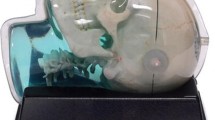Abstract
Introduction
Cerebral microbleeds have been observed in normal-appearing brain tissue of patients with glioma years after receiving radiation therapy. The contrast of these paramagnetic lesions varies with field strength due to differences in the effects of susceptibility. The purpose of this study was to compare 3T and 7T MRI as platforms for detecting cerebral microbleeds in patients treated with radiotherapy using susceptibility-weighted imaging (SWI).
Methods
SWI was performed with both 3T and 7T MR scanners on ten patients with glioma who had received prior radiotherapy. Imaging sequences were optimized to obtain data within a clinically acceptable scan time. Both T2*-weighted magnitude images and SWI data were reconstructed, minimum intensity projection was implemented, and microbleeds were manually identified. The number of microbleeds was counted and compared among datasets.
Results
Significantly more microbleeds were identified on SWI than magnitude images at both 7T (p = 0.002) and 3T (p = 0.023). Seven-tesla SWI detected significantly more microbleeds than 3T SWI for seven out of ten patients who had tumors located remote from deep brain regions (p = 0.016), but when the additional three patients with more inferior tumors were included, the difference was not significant.
Conclusion
SWI is more sensitive for detecting microbleeds than magnitude images at both 3T and 7T. For areas without heightened susceptibility artifacts, 7T SWI is more sensitive to detecting radiation therapy-induced microbleeds than 3T SWI. Tumor location should be considered in conjunction with field strength when selecting the most appropriate strategy for imaging microbleeds.



Similar content being viewed by others
References
Valk PE, Dillon WP (1991) Radiation-injury of the brain. Am J Neuroradiol 12(1):45–62
Lupo JM et al (2012) 7-Tesla susceptibility-weighted imaging to assess the effects of radiotherapy on normal-appearing brain in patients with glioma. Int J Radiat Oncol Biol Phys 82(3):e493–e500
Shobha N, Smith EE, Demchuk AM, Weir NU (2009) Small vessel infarcts and microbleeds associated with radiation exposure. Can J Neurol Sci 36(3):376–378
Charidimou A, Werring DJ (2011) Cerebral microbleeds: detection, mechanisms and clinical challenges. Futur Neurol 6(5):587–611
Greenberg SM et al (2009) Cerebral microbleeds: a guide to detection and interpretation. Lancet Neurol 8(2):165–174
Cordonnier C, Al-Shahi Salman R, Wardlaw J (2007) Spontaneous brain microbleeds: systematic review, subgroup analyses and standards for study design and reporting. Brain 130(Pt 8):1988–2003
Theysohn JM et al (2011) 7 tesla MRI of microbleeds and white matter lesions as seen in vascular dementia. J Magn Reson Imaging 33(4):782–791
Conijn MM et al (2011) Cerebral microbleeds on MR imaging: comparison between 1.5 and 7T. AJNR Am J Neuroradiol 32(6):1043–1049
Ayaz M et al (2010) Imaging cerebral microbleeds using susceptibility weighted imaging: one step toward detecting vascular dementia. J Magn Reson Imaging 31(1):142–148
Nandigam RNK et al (2009) MR imaging detection of cerebral microbleeds: effect of susceptibility-weighted imaging, section thickness, and field strength. Am J Neuroradiol 30(2):338–343
Lupo JM et al (2009) GRAPPA-based susceptibility-weighted imaging of normal volunteers and patients with brain tumor at 7 T. Magn Reson Imaging 27(4):480–488
Haacke EM et al (2004) Susceptibility weighted imaging (SWI). Magn Reson Med 52(3):612–618
Charidimou A, Krishnan A, Werring DJ, Rolf Jäger H (2013) Cerebral microbleeds: a guide to detection and clinical relevance in different disease settings. Neuroradiology 55(6):655–674
Ayaz M, Boikov AS, Haacke EM, Kido DK, Kirsch WM (2010) Imaging cerebral microbleeds using susceptibility weighted imaging: one step toward detecting vascular dementia. J Magn Reson Imaging 31(1):142–148
van Norden AG, van den Berg HA, de Laat KF, Gons RA, van Dijk EJ, de Leeuw FE (2011) Frontal and temporal microbleeds are related to cognitive function: The Radboud University Nijmegen Diffusion Tensor and Magnetic Resonance Cohort (RUN DMC) Study. Stroke 42(12):3382–3386
Werring DJ, Gregoire SM, Cipolotti L (2010) Cerebral microbleeds and vascular cognitive impairment. J Neurol Sci 299:131–135
Goos JD, Kester MI, Barkhof F et al (2009) Patients with Alzheimer disease with multiple microbleeds: relation with cerebrospinal fluid biomarkers and cognition. Stroke 40:3455–3460
Kinnunen KM, Greenwood R, Powell JH, Leech R, Hawkins PC, Bonnelle V, Patel MC, Counsell SJ, Sharp DJ (2011) White matter damage and cognitive impairment after traumatic brain injury. Brain 134(Pt 2):449–463
Scheid R, Preul C, Gruber O, Wiggins C, von Cramon DY (2003) Diffuse axonal injury associated with chronic traumatic brain injury: evidence from T2*-weighted gradient-echo imaging at 3 T. AJNR Am J Neuroradiol 24(6):1049–1056
Shaw EG (1990) Low-grade gliomas: to treat or not to treat? A radiation oncologist’s viewpoint. Arch Neurol 47(10):1138–1140
Jin Z, Xia L, Du YP (2008) Reduction of artifacts in susceptibility-weighted MR venography of the brain. J Magn Reson Imaging 28(2):327–333
Liu T et al (2012) Cerebral microbleeds: burden assessment by using quantitative susceptibility mapping. Radiology 262(1):269–278
Acknowledgments
The authors would like to thank Andre Cote, Adam Elkhaled, Angela Jakary and Trey Jalbert for their work in MR image acquisition and Bert Jimenez and Mary McPolin for their clinical coordination of patient MR scans. This work was supported by UC Discovery grant ITL-BIO04-10148, which is an academic-industry partnership grant with General Electric Healthcare, a UCSF REAC Cohn & Simon Memorial Fund and a fellowship from the Graduate Education in Medical Sciences (GEMS) training program funded by Howard Hughes Medical Institute (HHMI).
Conflict of interest
Grant support for this project was funded in part by GE Healthcare.
Author information
Authors and Affiliations
Corresponding author
Additional information
This study was presented in part at the 20th annual meeting of the International Society for Magnetic Resonance in Medicine, 2012, Melbourne, Australia.
Rights and permissions
About this article
Cite this article
Bian, W., Hess, C.P., Chang, S.M. et al. Susceptibility-weighted MR imaging of radiation therapy-induced cerebral microbleeds in patients with glioma: a comparison between 3T and 7T. Neuroradiology 56, 91–96 (2014). https://doi.org/10.1007/s00234-013-1297-8
Received:
Accepted:
Published:
Issue Date:
DOI: https://doi.org/10.1007/s00234-013-1297-8




